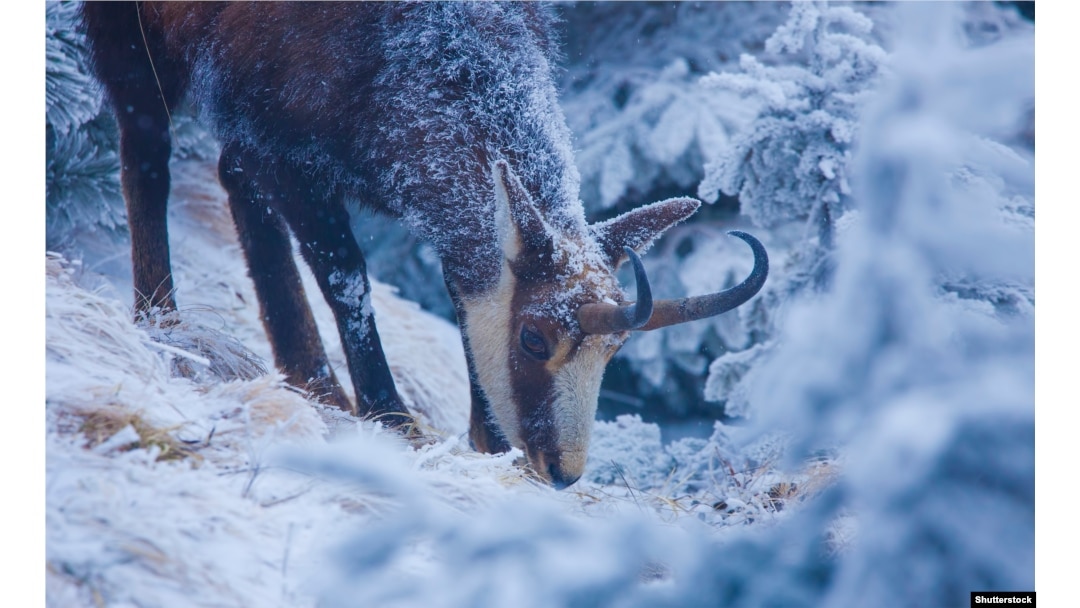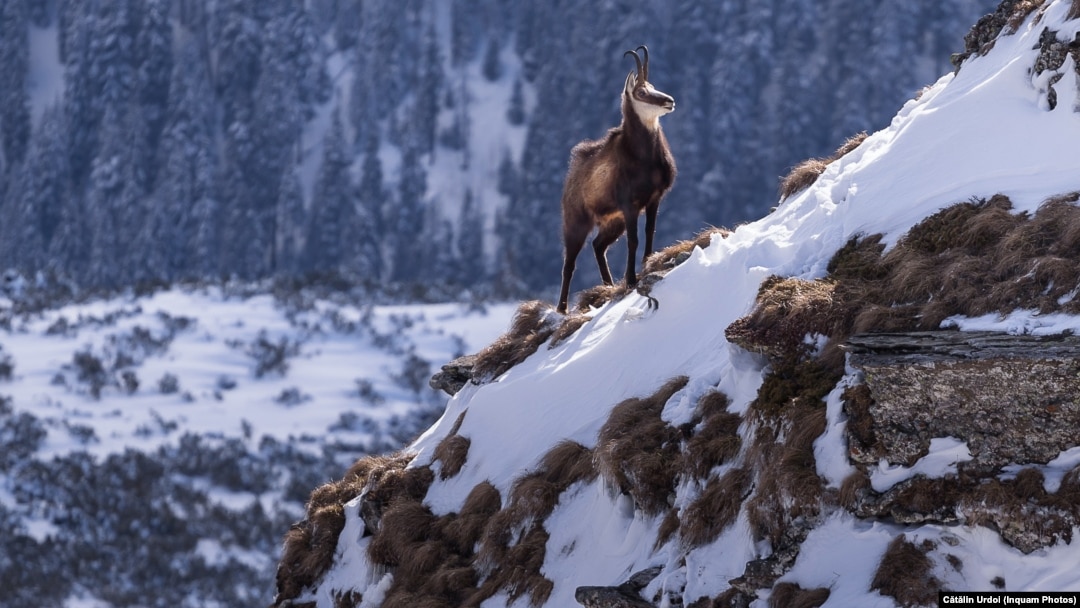BUCHAREST -- On October 12, a hunter in Moieciu in Romania's central Brasov County fell into a ravine, before eventually being saved by the country's mountain rescue service.
The Czech man, who was accompanied by two Slovak hunters, had gotten into difficulties while stalking Romania's famous black goat, an agile beast whose ability to skip up mountainsides at up to 50 kilometers per hour makes it tricky prey.
Romania's rugged and sparsely populated terrain and wildlife diversity have made it a popular destination for hunters seeking greater challenges than those found in Western Europe. But that popularity has also brought concerns, aired most vocally by conservation groups, that Romania's black goats are increasingly threatened and could one day face extinction.

A chamois grazes on grass underneath the winter snow.
According to Brasov police, all three foreigners had permits to hunt black goats at the Moieciu hunting ground, which is owned by the Brasov County Hunting and Sports Fishing Association.
Hunting is big business in Romania. According to an investigation by RFE/RL's Romanian Service, foreigners can pay between 700 and 10,000 euros ($811-$11,600) for a trip to hunt black goats there. That's much cheaper than similar packages in Western European locations such as Switzerland, Italy, or Austria. Florin Dadis, a hunting tourism expert, said a similar trip in Italy could cost up to 25,000 euros.
A Romanian postage stamp issued in 1993 honors the country's black goat.
The black goat, also known as the chamois, is found in mountainous habitats across Europe. The herbivores live in groups of at least five, led by older females, and can live up to 20 years. Known for their agility, the goats can jump up to 2 meters high and reach incredible speeds, even when ascending steep cliffs.
On bookyourhunt.com, an international platform that sells hunting services, the average price of a hunting package in Romania is between 2,000 and 3,000 euros for a three- or four-day stay. The package includes the hunting, accommodation, airport transfers, and food and drink.
"The mountainous regions of Retezat, Bucegi, where the black goats are found, are sparsely populated. They are really wild areas and perfect for such activities," Dadis said. "In Switzerland and Austria, black goats are in tourist areas and hunting is more dangerous. Here, black goats do not live in groups of hundreds, as we have seen in Austria or Switzerland.
He added that many hunters come not from Western Europe but from Arab states, Central Europe, or the former Soviet Union.
According to Romania's Environment Ministry, there are more than 8,000 black goats in the country. Each year, the ministry grants quotas to hunting associations around the country to limit the number of black goats that can be killed. Recent quotas have meant between 400 and 600 goats are allowed to be hunted each year.
The animals are known for their beauty and are an emblematic species in the Carpathian Mountains.
Conservation groups, however, have rejected the ministry's figures, saying the country's population of black goats is much smaller. They say the numbers are inflated to enable the continued hunting of the chamois. The last independent survey was carried out by the Romanian-based Foundation Conservation Carpathia in 2015-16, which estimated there were 4,000-6,000 black goats in Romania.
In Western Europe, populations of black goats are much higher, with an estimated 60,000 in France, 80,000 in Switzerland, 100,000 in Italy, and 250,000 in Austria.
The numbers are so low, conservation groups say, that in Romania's Fagaras, Leaota, and Rodna mountains, black goats are on the verge of extinction. In 2016, the Foundation Conservation Carpathia completed fieldwork in the Fagaras and Leaota mountains, where they found only 150 black goats. Twenty-five years ago, there were estimated to be over 1,000 black goats in the Rodna Mountains alone.
The black goats inhabit many of Romania's national parks.
Romania has already banned the hunting of some animals seen as increasingly threatened. In 2016, a new law prohibited the trophy hunting of bears and wolves.
Environmental NGO Declic has since called for a ban on the hunting of black goats, too. The proposal was reportedly well-received when Costel Alexe led the Environment Ministry between November 2019 and November 2020, but the draft bill never made it through parliament.
Instead of offering protection to at-risk species, critics say parliament has expanded hunters' rights. Parliamentary deputy Ioan Cupsa from the conservative National Liberal Party (PNL) supports an amendment to the existing 2006 legislation that would increase the number of species that can be hunted, including black goats. In October, that amendment was submitted to a specialized environmental commission in parliament for amendment, dismissal, or a vote.
Hunters are attracted by the often challenging terrain.
Cupsa told RFE/RL's Romanian Service that his proposal is aimed at culling species that destroy crops or attack households. Exceptions to hunting restrictions, known as derogations, have been granted before in specific cases where people or their homes are in danger.
Such a workaround was blamed in the controversial case in which a member of Liechtenstein's royal family was accused of killing Romania's largest bear for a 7,000-euro fee earlier this year.
In that case, the Environment Ministry reportedly gave permission for the shooting of a different bear -- a much smaller female -- after a farmer complained that the animal had repeatedly damaged his crops.
SEE ALSO: If Hunting Bears Is Illegal In Romania, Why Are Hundreds Killed Each Year?The death of Arthur, a 17-year-old male brown bear shot in Romania's central Covasna County in May, was regarded by many Romanians as a symbol of the country's political and economic woes.
SEE ALSO: Romanian Nationalists Weave Xenophobic Parable From Poaching Death Of 'Arthur The Bear'Conservation organizations believe that, given what they regard as the worryingly low number of black goats in the country, such derogations would be a travesty.
"The black goat is an emblematic species for the Carpathians and for Romania. However, in some areas it was hunted and poached to extinction, as is the case of the Rodna Mountains. It is currently protected only in areas where hunting is prohibited, such as national parks," explained Florin Stoican, who started the Declic campaign to protect the species.
Black goats on the mountain ridges of Ceahlau, close to the city of Piatra Neamt in northeastern Romania.
A quota has already been approved that allows 590 black goats to be hunted from June 23, 2021, to May 14, 2022. For the previous year, 510 goats were allowed to be killed; and the year before, 609. The hunting associations estimate that around 90 percent of the 2020 quota and 80 percent of the 2019 quota were killed.
Good business for the hunting companies, maybe. But for conservationists, it's the latest step toward endangering a new species.


